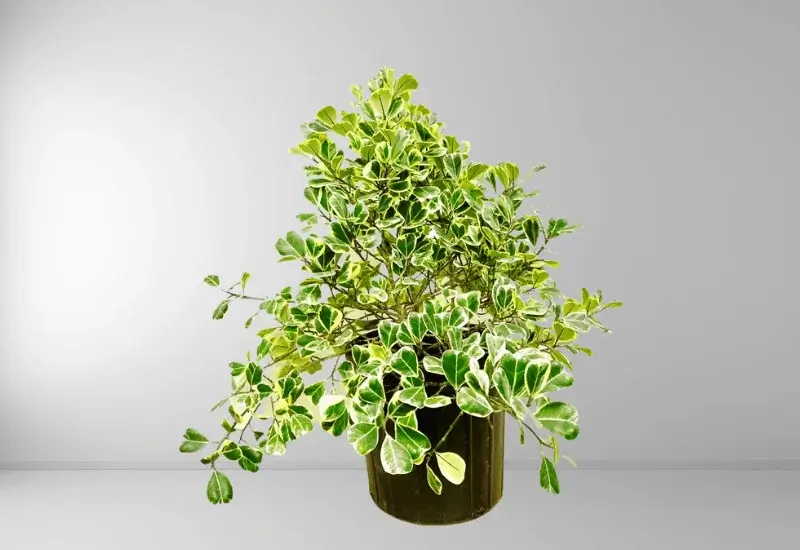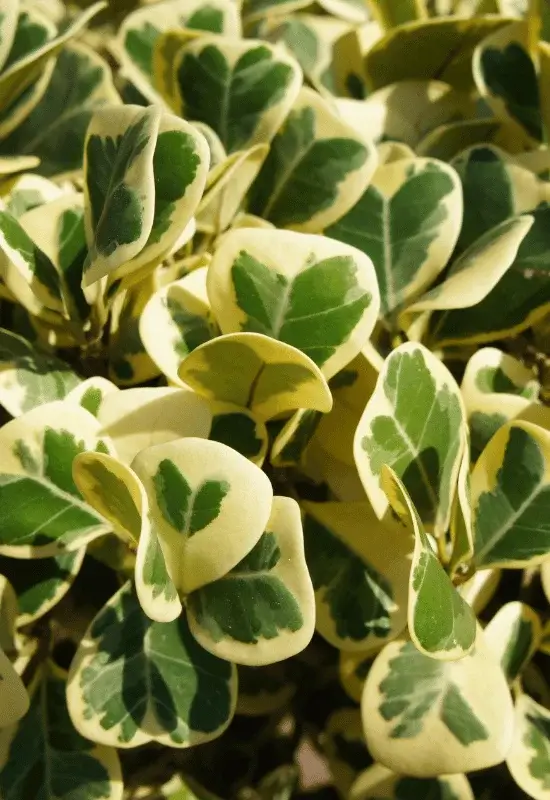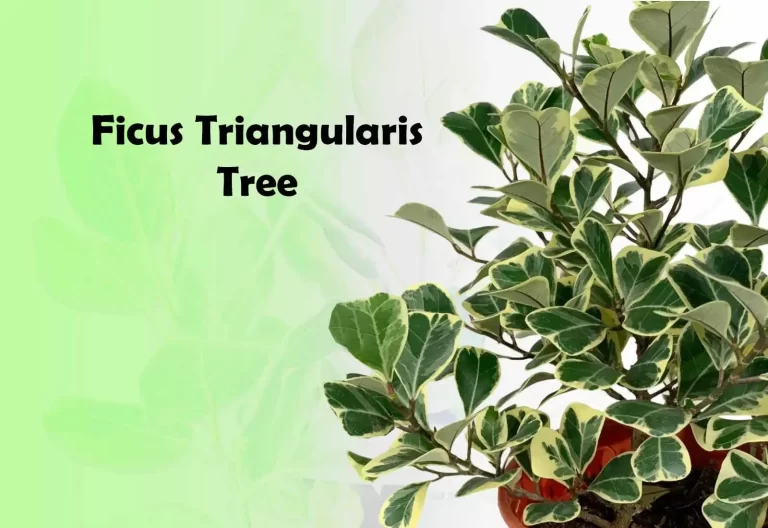Care for Ficus Triangularis and Ficus Triangularis Variegata
Ficus Triangularis and Ficus Triangularis Variegata plants, known for their unique triangular leaves and variegated patterns, are popular indoor and outdoor decor choices. This guide provides essential care tips to help you keep them thriving.
Ficus Triangularis Care

Ficus Triangularis, the Triangle Fig, boasts unique triangular-shaped leaves that require proper care and attention for optimal growth.
Also Read: Ficus Triangularis Tree
Overview of Ficus Triangularis
Description: Part of the Ficus family, known for its distinctive triangular leaves.
Appearance: Features glossy, medium-sized, dark green leaves, adding elegance to your space.
Usage: Popular choice for indoor and outdoor decoration due to its unique appearance.
Light Requirements
Optimal Light: Place in well-lit areas with bright, indirect sunlight for healthy growth.
Avoid Direct Sunlight: Protect from direct sun to prevent leaf scorching; north or east-facing windows are ideal.
Watering Guidelines
Watering Frequency: Water when the top inch (2.5 cm) of soil is dry; ensure good drainage.
Soil Moisture: Maintain consistent, moderately moist soil; avoid extremes of overwatering or underwatering.
Temperature and Humidity Considerations
Ideal Temperature: Thrives in warmth (65-75°F or 18-24°C); guard against cold drafts.
Humidity Preferences: Prefers high humidity; use misting or humidity trays, especially in dry indoor conditions.
Ficus Triangularis Pruning and Maintenance Tips

Trimming for Shape: Regular pruning with sharp shears maintains the desired shape.
Dealing with Yellow Leaves: Investigate soil moisture for yellowing leaves; prune for aesthetics.
Common Issues and Solutions
Yellowing Leaves: Adjust watering, maintain stable conditions, and remove affected foliage.
Leaf Drop: Ensure consistent temperature, humidity, and lighting; acclimate to environmental changes.
Pest Infestations:
- Monitor for aphids and mealybugs.
- Remove or use insecticidal soap.
- Isolate-affected plants.
Care of Ficus Triangularis Variegata

Triangularis Variegata, the Variegated Triangle Fig, is admired for its captivating variegated leaves, demanding proper care to showcase its unique beauty.
Ficus Triangularis Variegata
Description: Special Ficus Triangularis variety with variegated green and white leaves.
Visual Appeal: Ideal for indoor decoration, adding elegance and color to any space.
Optimal Light Conditions
Ideal Light: Thrives in well-lit areas with bright, indirect sunlight for vibrant leaf colors.
Avoid Direct Sunlight: Protect from direct sun to preserve delicate variegation; consider north or east-facing windows.
Watering Recommendations
Watering Routine: Water when the top inch (2.5 cm) of soil is dry; ensure proper drainage.
Maintain Moisture: Keep soil moist but not waterlogged; adjust watering based on indoor conditions and humidity.
Temperature and Humidity Preferences
Preferred Temperature: Flourishes in warmth (65-75°F or 18-24°C); shield from cold drafts.
Humidity Needs: Maintain high indoor humidity levels; use misting, humidity trays, or a humidifier.
Pruning and Maintenance for Variegated Varieties
Pruning for Aesthetics: Regular pruning with sharp shears maintains the desired shape.
Dealing with Yellow Leaves: Address yellowing leaves promptly; check soil moisture and prune for aesthetics.
Addressing Common Variegated Ficus Triangularis Issues
Yellowing Leaves: Adjust watering and maintain stable conditions; remove yellowed leaves.
Leaf Drop: Ensure consistent temperature, humidity, and lighting; acclimate to environmental changes.
Pest Management:
- Watch for pests like aphids and mealybugs.
- Remove or use insecticidal soap.
- Isolate-affected plants.
Ficus Triangularis Dropping Leaves
Leaf drop in Ficus Triangularis, often referred to as the Triangle Fig, can be a cause for concern. Understanding the underlying reasons and how to troubleshoot can help you maintain a thriving and vibrant plant.
Understanding Leaf Drop in Ficus Triangularis
What is Leaf Drop: Leaf drop is the natural process of leaves falling off the plant. However, excessive or sudden leaf drop can signal underlying issues.
Normal vs. Abnormal Leaf Drop: It’s essential to differentiate between normal leaf shedding, as older leaves naturally die off, and abnormal leaf drop resulting from stress or problems.
Common Causes of Leaf Drop
| Overwatering | Excess soil moisture can lead to root rot, causing the plant to shed leaves as it struggles to absorb water and nutrients. |
| Underwatering | Inadequate moisture can stress the plant, leading to leaf wilting and drop. |
| Environmental Stress | Sudden changes in temperature, humidity, or lighting conditions can trigger leaf shedding. |
| Pest Infestations | Common pests like aphids and mealybugs can weaken the plant, resulting in leaf drop. |
| Disease or Fungal Issues | Fungal or bacterial problems can impact the plant’s health and contribute to leaf drop. |
| Transplant Shock | Moving the plant to a new pot or location can lead to temporary leaf drop as it adapts to changes. |
| Poor Drainage | Insufficient pot drainage can lead to waterlogged soil, damaging roots and causing leaf drop. |
Troubleshooting and Remedies
| Adjust Watering | Monitor soil moisture and adapt your watering routine. Allow the top inch of soil to dry before rewatering. |
| Maintain Stable Conditions | Keep the plant in an environment with consistent temperature, humidity, and lighting to avoid abrupt changes. |
| Inspect for Pests | Regularly check the plant for common pests. If found, take action to remove them and prevent further infestations. |
| Address Soil Drainage | Ensure proper pot drainage to prevent waterlogged soil, which can harm roots and lead to leaf drop. |
| Prune-Affected Leaves | If you observe dropped or severely affected leaves, prune them with clean, sharp shears to encourage new growth. |
| Isolate Affected Plant | In cases of suspected disease, isolate the plant to prevent it from spreading to nearby plants. |
| Patience | Sometimes, leaf drop is a temporary response to environmental changes. Be patient and give the plant time to adapt. |
Ficus Triangularis Propagation
Propagating Ficus Triangularis, also known as the Triangle Fig, offers a rewarding way to create new plants from an existing one. Discover the methods, step-by-step guidance, and tips for successful propagation.
Methods of Propagating Ficus Triangularis
There are two primary methods for propagating Ficus Triangularis:
Stem Cuttings: This common method involves taking a healthy stem, cutting with a few leaves, and encouraging it to develop roots.
Air Layering: A more advanced technique, air layering, stimulates roots to grow on a branch while they remain attached to the parent plant.
Step-by-Step Guide to Propagation
Stem Cutting Propagation:
Prepare Your Materials: Gather clean, sharp pruning shears or scissors, a small pot with well-draining soil, and a plastic bag or wrap.
Select a Healthy Cutting: Choose a stem free from damage or disease, with a few leaves on it.
Take the Cutting: Use pruning shears or scissors to make a clean cut just below a leaf node (where a leaf attaches to the stem). Aim for a 4-6 inch (10-15 cm) cutting.
Remove Lower Leaves: Strip away the lower leaves, leaving a few at the top.
Let the Cutting Callus: Allow the cut end to air dry and form a callus, which helps prevent rot during planting.
Plant the Cutting: Place the cutting in the pot with well-draining soil, lightly watering to settle the soil around it.
Create a Mini Greenhouse: Cover the pot and cut it with a plastic bag or wrap to create a mini greenhouse, maintaining humidity.
Place in Indirect Light: Position the pot in a bright, indirect light spot, avoiding direct sunlight.
Monitor and Water: Keep the soil moist (but not soggy). Check for root development after a few weeks to a few months.
Tips for Successful Propagation
Timing: Spring and early summer are prime times for propagation when the plant is actively growing.
Humidity: Maintain high humidity around the cutting by misting it or using a humidity tray.
Patience: Propagation may take time, so be patient and allow the cutting to establish roots before transplanting.
Rooting Hormone (Optional): While not always necessary, you can use rooting hormone powder to encourage root growth.
Conclusion
Ficus Triangularis and Triangularis Variegata are visually captivating plants. To ensure their well-being, provide proper lighting, watering, and attention to their unique characteristics. When cared for diligently, these versatile plants can be a stunning addition to your indoor or outdoor space.



